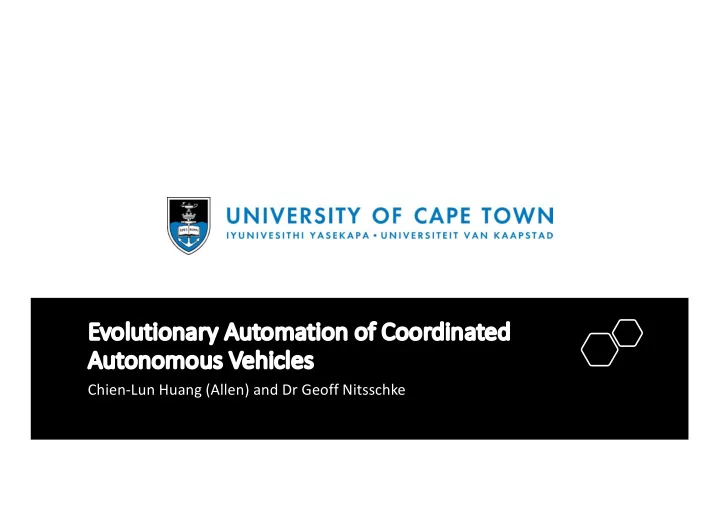

Ev Evolutionary Automation of Coordinated Aut Autono nomous us Vehi hicles Chien-Lun Huang (Allen) and Dr Geoff Nitsschke
• Increased research in adaptive control systems for autonomous vehicles. • Existing research focuses on autonomous control of single vehicle or limited noise in Motivation the environment • Little research into comparison between various evolutionary search methods for autonomous vehicle behaviour
Neuro-Evolution of Augmenting Topologies (NEAT) directed evolutionary search. We compared three different search methods: 1. Objective-based 2. Behaviour-based (Novelty Search) Methods 3. Hybrid (Objective + Behaviour) Goal: evolve effective and efficient coordinated driving behaviour through given roads
Neuro-Evolution of Augmenting Topologies (NEAT) directed evolutionary search. We compared three different search methods: 1. Objective-based Methods
Neuro-Evolution of Augmenting Topologies (NEAT) directed evolutionary search. We compared three different search methods: 1. Objective-based 2. Behaviour-based (Novelty Search) Methods k – k-Nearest Neighbours in generation + archive dist – Euclidean Distance μ – i th nearest neighbour X – behaviour w.r.t novelty metric Behaviour Characterisation: Speed and Cohesion, Speed * and Location *experimentally determined
Neuro-Evolution of Augmenting Topologies (NEAT) directed evolutionary search. We compared three different search methods: 1. Objective-based 2. Behaviour-based (Novelty Search) Methods 3. Hybrid (Objective + Behaviour) ρ = 0 . 5, equally combining fitness and novelty Fitness and Novelty score normalised before combination
Two sets of Experiments: • Evolution Experiment • Fitness, Novelty and Hybrid to determine which performs the best in evolving vehicle driving behaviour. Experiments • Generalisation Test Experiments • Highest-performance evolved controllers were tested with various different configurations (including unseen configurations [vehicle pool sizes] and environments [tracks]) • Non-evolutionary, evaluation of evolved controllers.
Simulation Environment • UnityNEAT • 3D hi-fidelity game engine • Vehicles • Modelled after pedestrian vehicle BMW M3 Experiments • Pooled in groups of 1, 3 and 5 • Task • 1 track for evolution with static and dynamic obstacles • 3 additional unseen tracks for evaluation experiments – each with static obstacles and varying altitude • Checkpoints placed equally spaced along track
Vehicle configuration • 5 Pyramidal Sensors fanning out the front of vehicle • Each sensor input into Neural Network + bias, angle to next waypoint and current velocity
Vehicle configuration • Hidden Layer (H1 in this diagram) • Output for steer and acceleration
Vehicle • 1 vehicle • 3 vehicles Configuration • 5 vehicles
Evolution Track
Evaluation Track 1
Evaluation Track 2
Evaluation Track 3
Results Evolution Results: Hybrid > Objective (Fitness) and Hybrid All Methods achieved > 60% task performance. Supports existing research that hybrid approach can improve task performance in this type of task
Objective-based (fitness) Evolution Results Behaviour-based (novelty search) Search space exploration heatmaps for each method indicates: • O: 60% of all evolved controllers in range between 0.2 and 0.4 task performance for all generations • N: Wider spread of controller behavior – expected from novelty search since it’s a behavior maintenance technique, but low task performance overall. 80% within 0.0 and 0.3 task performance. • H: Even-spread of solutions, broader search space than both O and N, was able to achieve higher task Hybrid performance due to this.
Results Evaluation Results: Objective (Fitness)-evolved controllers generalized the best Hybrid-evolved controllers generalized the worst
Evaluation Results Visualization of fittest controllers by each method (O, N, H) helps explain hybrid’s high task-performance on evolution track but inability to generalize as well as O and N. Both O and N evolved higher neural complex controllers whereas Hybrid evolved reactive networks that performed well on the evolution track only.
Thank you Please send questions to: allen@allenhuang.net / gnitschke@cs.uct.ac.za
Recommend
More recommend